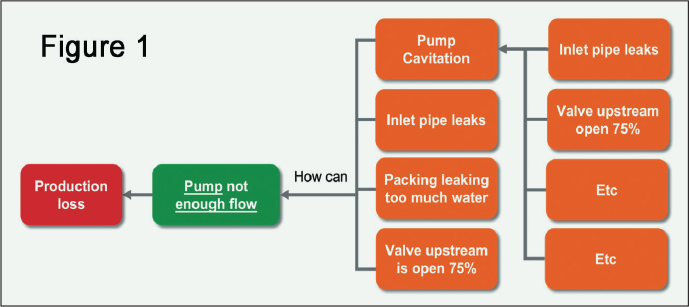It is easy to make mistakes when performing a Root Cause Failure Analysis (RCFA)—we have all done it. This article will show you two common mistakes and how to overcome them.
MISTAKE #1: THE PROBLEM WITH PROBLEM STATEMENTS
I have found that most people put too much information into a problem statement. Often you will want to write everything that happened and everything you know. This makes it very confusing for the people who are tasked with solving the problem.
Here is an example of observations of a cavitating pump:
- Pump sounds as if it is cavitating
- Bearings are hotter (183°F) than normal
- Valve upstream is open 75 percent
- Operator said she heard a noise around the pump at 4:30 a.m.
- The packing is leaking too much water
- The pump is not delivering enough flow (based on flow meter)
- There is a leak in the inlet pipe 4 ft before pump inlet
Much of this information is useful, but some is irrelevant. Avoid using all the information in the problem statement. This list has seven different problems, all with different objectives.
To overcome this common mistake, I am going to give you an example using one of the statements. I am choosing “The pump is not delivering enough flow” for the problem statement because the lack of pump flow is the most important problem to solve.
Another common mistake people make when developing problem statements is assuming what the problem is before investigating it. It is easy to see a problem and have a preconceived idea about the cause, but in the long run this creates more time spent on the problem.

Here’s another example. A crew was presented with this description: “the hydraulic cylinder was moving erratically and too slowly.”
With only this information, the group assumed that there was mechanical resistance on the rod. So, they started working on it based on that assumption. A couple of hours later, without fixing the problem, they rewrote the problem statement to reflect what they saw, which was “hydraulic cylinder moving too slowly.”
Upon further inspection, the crew found there was an internal leak in the cylinder. The problem statement wasn’t a fact; it was an assumption. Having the correct problem statement would have saved the crew several wasted hours.
MISTAKE #2: NOT KEEPING VITAL INFORMATION AND MATERIALS
Saving parts and organizing information is a common RCFA issue for many teams. Creating a culture of saving parts in your organization is vital. No matter how much time you spend on site, chances are you won’t be there when something breaks, so saving parts and making sure they are bagged and tagged correctly is very important.
In our experience, it works very well to create a specified area where broken pieces are stored. It could be a separate room with shelves or any area in the plant that is appropriate.
Taking the time and effort to make sure your crew is properly trained in bagging and tagging saves time in the long run. For example, let’s say there is a broken shaft or fractured surfaces. Your team needs to be trained to recognize that trying to fit them together will just destroy the fracture surfaces; instead, preserving the fracture surfaces using a light oil is the correct procedure.
Teach your team to take photos so there is a visual record of the exact problem they found at the time it was discovered. Then they just need to bag, tag, and place the parts in the exact area for investigation. As you know, when performing a root cause, it’s almost impossible to do it correctly if you don’t have the broken equipment or parts.
Create a system for organizing and identifying the parts. This could be as simple as numbering or having a log sheet to identify parts and another that tracks their correct location.
Making sure your problem statements and spare parts organization are correct can help allow you to use the RCFA process for everyday problems more easily.
 Paper 360
Paper 360
